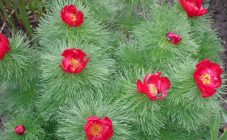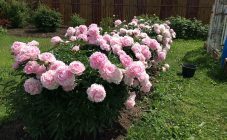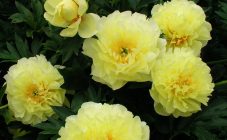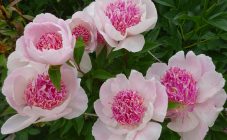Content:
In the modern garden, as in the fashion industry, some plants are receding into the shade, while others, gaining popularity, take center stage in the garden landscape. These popular novelties include ITO peonies. They are hybrids of the herbaceous milky-flowered Kakoden and the tree-like Kinko with yellow flowers. One of the many varieties of ITO hybrids that have won the love of gardeners is Coral Sunset. It is from the famous series of coral peonies by breeder Samuel Wissing, which he registered in the mid 60s of the 20th century. Coral Charm, Coral Sunset and Coral Supreme peony are the most popular herbaceous interspecific hybrids.
Botanical description
The Coral Sunset peony is a perennial herb in the Peony family (Paeoniaceae). It is an interspecific hybrid, therefore it shows signs of both herbaceous and tree-like peonies.
From tree species, the variety inherited a semi-double flower, its double color, leaf shape, lignified root and renewal buds formed underground.
From herbaceous species, Coral Sunset inherited the annually dying upper part and flowering on the tops of one-year-old shoots that grow in spring.
The bushes spread their densely leafy branches widely. They stand up straight, and do not lie on the ground under the weight of huge flowers. They grow up to 1 meter in height. Bloom in mid-June.
The leaves are narrow, long, delicate, bright green.
The roots are superficial, grow to the sides, lignify over time.
Semi-double flowers bloom on a one-year-old shoot. The color is bright salmon, lighter in the middle and more saturated at the edges of the petals. The petals are arranged in 5-7 rows. Inside the bud are bright yellow pistils and anthers that attract insects. The size of the first opened buds can reach 20 cm, the subsequent lateral buds will be much smaller.
Flowering occurs gradually, several buds open at the same time. Due to their large number, the flowering period of coral peonies lasts much longer than that of ordinary varieties. Ito hybrids, unlike ordinary varieties, practically do not smell.
Coral Sunset Peony is classified as a mid to late flowering cultivar. In one place, a plant can live 40-50 years.
During flowering, the color of the petals changes. They reach the greatest beauty and brightness at the moment of full disclosure, and after a few days they begin to fade and become milky yellow.
Agrotechnics
All the main species of peonies grow in the mountains, they are accustomed to cold weather and rocky soil. Peonies are best suited for growing in the middle lane and in the south of Russia. Even loams of the Moscow region are suitable for them, so long as the roots are not constantly in the water.
Sunset Peony will grow well in an open, sunny location. You should not plant a bush next to trees and buildings, where moisture stagnation or excessive moisture during precipitation is possible.
Coral peonies do not like acidic soil. Before planting, it must be deoxidized with dolomite flour or lime.
The composition of the soil can be any (loam, sandy, stony), it is important that good drainage is created during planting. There is no need to make a special potting mix for Coral Sunset.If you want to improve the soil on the site, then you can mix garden soil, peat and compost in equal parts. Fill the planting hole for the peony bush with this mixture.
The size of the planting pit depends on the size of the plant root. When planting, flower buds should be close to the ground. This way they can get the warmth they need for growth. If the root is large, you can lay it on its side or set it in a hole at an angle. Ito hybrids over time are able to arrange the roots themselves in a way that suits them. Also, coral peonies of the Coral Sunset variety are able to independently deepen the growth buds to the required depth.
The best time to plant the Coral Sunset herbaceous peony is early fall. Planting in autumn will give the plant time to grow small suction roots, and in spring it will be better supplied with moisture.
Planting seedlings in spring is associated with little risk and additional care for the young plant. A plant that has not had time to take root requires more watering and shelter from the scorching rays of the sun in hot weather. Before planting, the seedling does not need to be soaked in special solutions that stimulate growth. Peonies will begin to show activity only when their roots are in the ground.
Care
Caring for Coral Sunset peonies is easy. This plant, after successful planting and adaptation to a new place, will require only regular and moderate watering.
On hot days it is necessary to increase the amount of water, and in rainy summers, additional measures should be taken to save the roots from excessive moisture and decay. For this, the tablets of the drug Glyocladin are instilled five centimeters from the bush. Alirin or Gamair preparations are dissolved in water. This solution (1 liter of water and 1 tablet of the drug) is sprayed on the bush, which helps to save the rhizomes from rot.
Coral peonies get all the nutrients they need from rainwater. If watering is carried out with tap water, then you can apply fertilizers in the form of an aqueous solution of ash (1 glass per 1 bucket of water) or mix dolomite flour with soil near the bush.
During the growing season, you can feed the plant with nitrogen-containing fertilizers, and then add mineral complexes containing fluorine.
For quick root growth, the first buds can be removed from the bush. But, if the plant was not purchased for reproduction, then this is not necessary.
A bush can be transplanted at any time if the place does not suit him. To do this, you do not need to wait for autumn or spring, the plant will suffer more if it remains in the place where it feels bad. After transplanting at an inopportune time, additional care of the peony will be required. It must be protected from the sun and watered regularly.
Reproduction
The seed method is very rarely used by amateur gardeners, because:
- Peonies produce very few seeds.
- Seed germination is very low.
- Parental traits may not show up in plants grown from seeds.
- A full-fledged bush will appear 5-6 years after sowing the seeds.
The easiest and most affordable way to increase planting material is to divide the bush.
It is best to divide the bush at the age of 4-5 years. At a later age, the root becomes very hard and it is very difficult to separate it without significant losses.
The main problem of dividing an adult bush of Ito-hybrids is in the form of root growth. Herbaceous milky-flowered varieties give many root weaves. They are easy to separate or cut with a bud of growth for further propagation without much damage to the main bush. In Ito-pions, all branches converge at one point, then there is a small isthmus, and a root is formed from it. To separate part of the bush, you need to cut this isthmus. It is convenient to do this with a sharp knife with a thin blade.Cutting points must be treated with disinfectants and dried. After this, the delenki can be planted in a new place.
Preparing for winter
Peony Coral Sunset is decorative until frost. Its foliage turns brown with purple hues. After the first frost, the entire aboveground part of the bush is cut off.
In a winter with little snow, the bushes are covered with mulch (half a bucket per bush). If winter is generous with snow, then shelter is not required.
Diseases and pests
Peonies are very strong and hardy plants, but if the bush begins to wither, the flowers become smaller, and the foliage is not so dense, then you need to dig it out in order to understand the reason for this behavior.
This may be the formation of rot in the roots of the plant due to excess moisture. Then it is necessary to remove the affected areas and, having made good drainage, transplant the bush to a new place.
The disease can be caused by the age and fatigue of the plant. In this case, the bush must be divided for rejuvenation to occur.
Ito hybrids are resistant to fungal diseases such as rust and botrytis, which very often affect the leaves of common herbaceous peonies. But the fungal environment is constantly growing and improving. Perhaps, in a few years, such fungal spores will be hatched, which will also infect varieties of hybrids.
Gall nematodes and ants most commonly attack peonies. Gall nematode settles in the roots of the plant. Getting rid of it is very difficult. A plant affected by a nematode begins to wither, stunted, and then bloom. It must be destroyed, and the landing site must be treated with formalin. This will not bring a hundred percent result, but it will help stop the spread of the pest over the site.
Ants love to feast on the juice released from the buds of the plant. To drive them away, the buds can be washed in a warm solution of soapy water, and to get rid of them forever, you need to treat the bush with a Fufanol solution.
If ants have settled under a peony, this is a signal that the plant is not healthy, and measures must be taken to treat it. Ants never settle near healthy plants.
Coral Sunset in the landscape
The Coral Sunset peony bush looks great in solitary plantings, because, having inherited the strength of the branches from the tree species, it never falls apart and has a good habit.
In addition, unlike herbaceous species, Coral Santset has a long growing season. Even after flowering, its foliage fills the garden with bright greenery all summer, and with the onset of cold weather the leaves turn purple, and the garden lights up with fire.
At the first frost, branches and leaves are covered with silver frost, which looks very beautiful against the background of dying nature. This gives the peony bush a new, albeit short life, as a new art object.
In group plantings, peonies occupy a central place. In the scheme of such a planting, it is necessary to assign a place to Coral Sunset, which will have a good view from various parts of the garden.
Coral Sunset peonies are loved by florists because they look good both in group compositions and in solo bouquets.

















